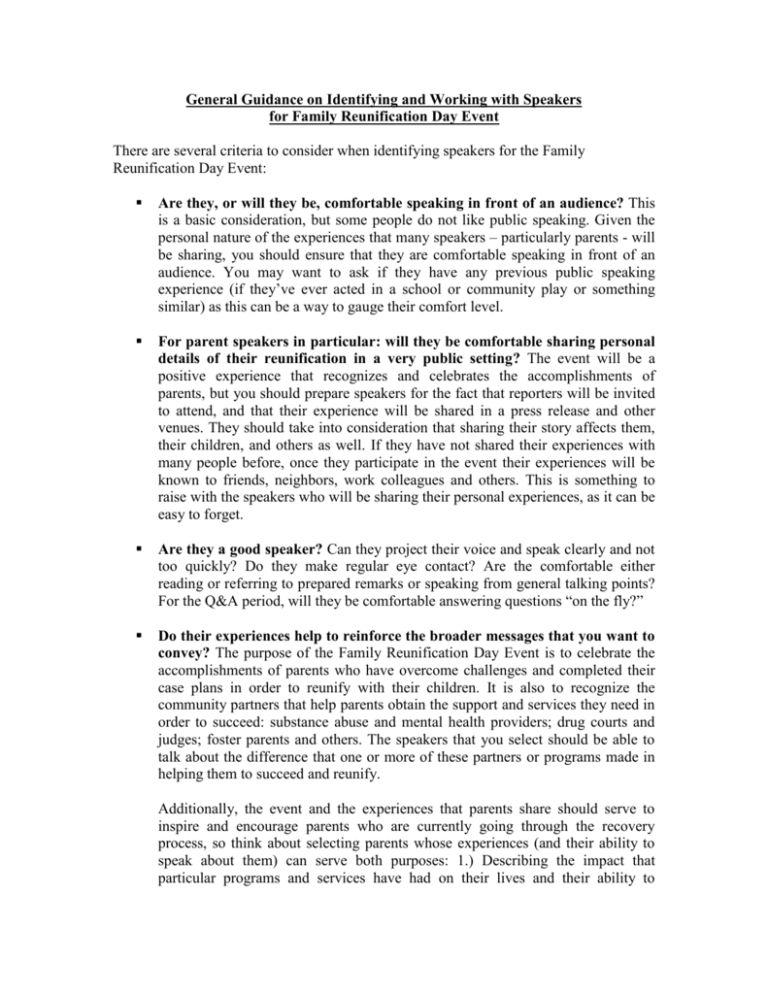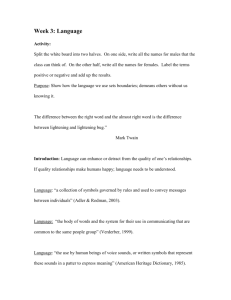Guideline for Identifying Speakers
advertisement

General Guidance on Identifying and Working with Speakers for Family Reunification Day Event There are several criteria to consider when identifying speakers for the Family Reunification Day Event: Are they, or will they be, comfortable speaking in front of an audience? This is a basic consideration, but some people do not like public speaking. Given the personal nature of the experiences that many speakers – particularly parents - will be sharing, you should ensure that they are comfortable speaking in front of an audience. You may want to ask if they have any previous public speaking experience (if they’ve ever acted in a school or community play or something similar) as this can be a way to gauge their comfort level. For parent speakers in particular: will they be comfortable sharing personal details of their reunification in a very public setting? The event will be a positive experience that recognizes and celebrates the accomplishments of parents, but you should prepare speakers for the fact that reporters will be invited to attend, and that their experience will be shared in a press release and other venues. They should take into consideration that sharing their story affects them, their children, and others as well. If they have not shared their experiences with many people before, once they participate in the event their experiences will be known to friends, neighbors, work colleagues and others. This is something to raise with the speakers who will be sharing their personal experiences, as it can be easy to forget. Are they a good speaker? Can they project their voice and speak clearly and not too quickly? Do they make regular eye contact? Are the comfortable either reading or referring to prepared remarks or speaking from general talking points? For the Q&A period, will they be comfortable answering questions “on the fly?” Do their experiences help to reinforce the broader messages that you want to convey? The purpose of the Family Reunification Day Event is to celebrate the accomplishments of parents who have overcome challenges and completed their case plans in order to reunify with their children. It is also to recognize the community partners that help parents obtain the support and services they need in order to succeed: substance abuse and mental health providers; drug courts and judges; foster parents and others. The speakers that you select should be able to talk about the difference that one or more of these partners or programs made in helping them to succeed and reunify. Additionally, the event and the experiences that parents share should serve to inspire and encourage parents who are currently going through the recovery process, so think about selecting parents whose experiences (and their ability to speak about them) can serve both purposes: 1.) Describing the impact that particular programs and services have had on their lives and their ability to reunify with their children, and 2.) Talking about their experiences in a way that will motivate parents who are now going through the recovery process. When Assembling Your Speaker Lineup, Consider the Following: Don’t have too many – or too few – speakers. If you have an event that lasts an hour, you can probably have a maximum of 5 speakers. If you have too many speakers, it is hard to keep the overall event messages front and center, and if you have too few, the audience tends to get restless. Having 4 or 5 speakers, each of whom speak for about 8 minutes, along with a question and answer period at the end of the event, works well. Assemble a good mix of speakers. Have both men and women, and speakers of different ages, races and ethnicities. Keep in mind that the event is about families that have reunified and that the audience is going to be most interested in hearing directly from these parents. Additionally, think about including others who can contribute to telling this story – for example, a young person who was successfully reunified with their parent (either have them speak alongside their parent, or have them speak by themselves). Or a foster parent who worked to help a birth parent reunify with their child/children and can talk about how they did this. And you will likely want to have a service provider (or more than one) speak. They can address the role that services and supports play in helping reunify families, provide data, and reference the experiences of parents and families they have worked with who have successfully reunified. Introduce your speakers to one another before the event. You can achieve this either with in-person meeting or via conference call. All of your speakers should have the opportunity to meet one another and to exchange basic information before the event. This helps to establish a comfort level among speakers, and helps them to see where they fit in terms of the larger event. You can either have one “bigger” meeting, where you introduce everyone and also address logistic information (confirming the event time and location, reviewing speaker order, any other information that needs to be provided); or have two meetings, one that serves more as a “get to know you” and one that deals strictly with event logistics. It is also a good idea to ask each of your speakers to arrive early for the event (between 30 and 45 minutes) to ensure that they are there for the start of the event, and so that you can meet with them and review the event lineup, timing, and any last minute details, and answer any final questions they may have. Make sure there are no surprises. Once you have assembled your event speakers, and you begin the process of crafting brief bios for each, working on draft remarks, the press release, op-ed and other materials, you will want to establish a process for sharing this information with the speakers in advance, so they have the chance to review it and make any changes. This is particularly important for the bios, the press release if they are being quoted, and the op-ed if they are authoring or co-authoring the piece. Make certain that they are not seeing all the materials for the first time at the actual event – share everything in advance so that they are a true part of the process. Establish a “comfort zone” for speakers, especially parents and youth. The event is designed to celebrate the accomplishments of parents who have reunified with their children, but in telling the story of how they achieved this success, parents will also have to talk about experiences and incidents that are deeply personal. When you are working with parents to craft their remarks and draft their bios, make certain that they know that their comfort and ease in sharing details is of primary importance. If they do not wish to share their children’s names, for example, they do not have to. Or, if there are particular parts of their story that they are uncomfortable discussing, work with them to find a way to phrase them in a way that makes them comfortable or leave them out if they can be left out easily (unless they are critical elements of their experiences). This is true not just for their remarks during the event, but for the Q&A period and for any media interviews that they may do. If they are not comfortable answering certain questions, let them know that they can simply respond that way. Or, if they are asked a question that they do not know the answer to, it is perfectly okay to say that they don’t know. To ensure that parents – and all speakers – are comfortable answering questions, you may want to prepare them by putting together a list of sample questions they may be asked, and working with them on responses.





